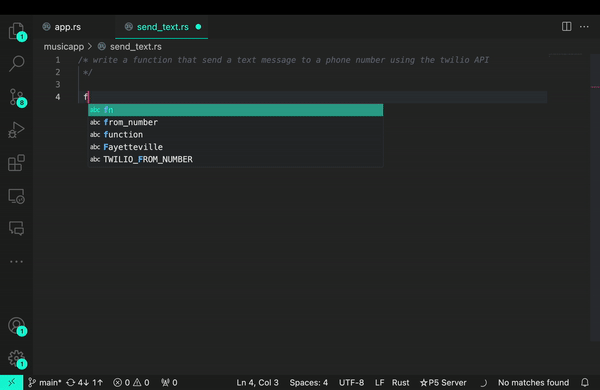Learn how open source developers are making the command line more friendly—and more powerful.
Why Rust is the most admired language among developers
Rust continues to top the charts as the most admired and desired language by developers, and in this post, we dive a little deeper into how (and why) Rust is stealing the hearts of developers around the world.

For the eighth year in a row, Rust has topped the chart as “the most desired programming language” in Stack Overflow’s annual developer survey. And with more than 80% of developers reporting that they’d like to use the language again next year, you have to wonder how a language created less than 20 years ago has stolen the hearts of developers around the world.
In this article, we’ll look at the history of Rust, what it’s commonly used for, why developers love it so much, and some resources to help you start learning one of the top fastest growing languages on GitHub.
So, what is the Rust programming language?

Rust’s print macro displaying the output “Hello, World!”
Originally intended to serve as a safer alternative to C and C++, Rust is a systems programming language that has gained significant popularity among developers thanks to its emphasis on safety, performance, and productivity. Rust is a statically typed language, so variable and expression types are determined and checked at compile time, which helps enhance memory safety and error detection, resulting in more reliable builds.
In 2006, the software developer, Graydon Hoare, started Rust as a personal project while he was working at Mozilla. According to an interview with MIT Technology Review, the inspiration for Rust came from a broken elevator in Hoare’s apartment building. The software for the lift operation system had crashed and Hoare understood that issues like this usually came from problems with how a program uses memory.
Quite often, the software for these types of devices is written in C or C++, but these languages require significant memory management, which can lead to errors that would cause the system to crash. So, Hoare set to work on figuring out how to create a programming language that could be both compact and memory bug-free.
He later showed the project to a manager—which led to Mozilla sponsoring it in 2009 as part of a longer-term effort to incorporate the language into the development of an experimental browser engine. In 2010, Mozilla Research officially announced the Rust project and released the source code to the public as an open-source project. After several years of development, Rust reached a stable and mature state—and in May 2015, Rust 1.0 was released. This milestone signaled that Rust was ready for production and provided a foundation for developers to build upon.
Since the 1.0 release, Rust has exploded in popularity and adoption, with top applications, such as Microsoft Windows, utilizing Rust to rewrite core libraries with its memory-safe code. Outside of the tech giants, Rust also has a vibrant community of developers, or “Rustaceans,” that are dedicated to making the Rust experience an active and collaborative one.

Meet Ferris, the unofficial mascot for Rust!
According to a recent survey by SlashData, there are roughly 2.8 million Rust developers worldwide in 2023, a number that has nearly tripled over the past two years. With plenty of active forums, documentation, and a supportive community for developers of all skill levels, it’s perhaps unsurprising that Rust keeps topping the most-desired language lists.
What makes Rust special?
So, what are some of Rust’s key features that make it so attractive to developers?
In simple terms, Rust solves some of developers’ most frustrating memory management problems commonly associated with C and C++, but that’s not its only shining capability. One of GitHub’s staff software engineers, Jason Orendorff, who co-authored a book on programming with Rust, said about the language:
“To me, what’s great about Rust is that it’s both fast AND reliable,” according to Orendorff. “It lets me write multi-headed programs that run on 16 cores and keep them readable, maintainable, and crash-free. It also lets me write very low-level algorithms requiring control over memory layout and pull in a crate that makes HTTPS requests super simple. It’s the combination of these features that makes Rust so unique.”
Building on that, here’s a few more of its well-loved characteristics and features:
- Concurrency. Rust has built-in support for concurrent programming through its ownership system which enforces strict rules for data access, and its borrowing model, which prevents data races by allowing controlled, simultaneous access. This ensures that multiple threads can work on shared data without introducing memory-related issues.
-
No garbage collection. Unlike some programming languages, Rust does not employ garbage collection. Instead, its ownership and borrowing rules manage memory, which helps empower developers to have precise control over memory allocation and deallocation for efficient resource management.
-
Cargo Package Manager. Rust’s built-in package manager, Cargo, streamlines project management, dependency tracking, and building, which helps contribute to efficient and organized development workflows. But this doesn’t make it clear just how bonkers the Cargo ecosystem is. According to Orendorff, “My team takes advantage of high-quality open source packages for hashing, serialization, multithreading, data structures, compression, and a lot more. These are performance-critical libraries. Without some of these, our project to rethink code search on GitHub wouldn’t have been possible.” And here’s a fun fact: Rust was actually the first systems programming language to have a standard package manager, and, as a result, the Rust ecosystem is incredibly robust.
-
Zero-cost abstractions. This feature allows developers to write high-level code abstractions and features without introducing any runtime performance overhead.
-
Pattern matching. This powerful language feature enables developers to concisely and effectively match complex data structures against specific patterns to extract and handle different cases or scenarios in a clean and readable manner.
-
Type inference. This feature allows Rust’s compiler to automatically detect an expression based on context while you code. “Many programming languages have some type inference,” Orendorff said. “C# and C++ have some, Rust has a little more, and languages like Haskell, Scala, and ML have even more.”
fn main() {
break rust;
}
Run this code for an inside joke among Rust developers 😆
What is Rust commonly used for?
Thanks to its direct access to both hardware and memory, Rust is well suited for embedded systems and bare-metal development. And since it’s a general purpose language, it can also be used for a variety of applications.
Let’s explore a few key use cases:
Using Rust to build performance-critical backend systems
Performance-critical backend systems are software components or services that handle tasks that require high-speed processing, low-latency responses, and efficient resource utilization—and Rust’s performance, thread safety, and error handling make it an excellent choice for developing these types of systems. In fact, we use Rust to build some of these systems at GitHub. For example, the backend of our code search feature is written in Rust (and you can read more about the development of GitHub’s newest code search with Rust, too).
Using Rust to develop operating systems
Rust was originally created to solve an operating system issue (remember the elevator problem?)—so, unsurprisingly, it’s often used to build operating systems, kernels, device drivers, or other low-level components where control over memory and performance is crucial. Redox, a Unix-like operating system, was written in Rust, which contributes to its most crucial feature: its security. “Fuchsia is another example that was built at Google,” Orendorff said. “If you have a Google Nest smart speaker, it’s likely running Fuchsia.”
Rust for operating system-adjacent code
Rust is also well-suited for writing code that performs tasks that closely interact with the operating system. For example, the Codespaces team at GitHub is leveraging Rust to enhance the speed of starting up the virtual disk within GitHub Codespaces and optimize the utilization of Azure storage. Coursera also employs Rust in its online grading system, as it operates within Docker and needs a language that compiles to machine code with minimal dependencies.
Using Rust for web development
Rust is increasingly being used for web development—especially on the server side. The async programming model and performance characteristics of Rust make it fitting for building high-performance web servers, APIs, and backend services. Plus, there’s been an influx of web frameworks for Rust, like Rocket, that can help folks get started with writing secure web applications. The emergence of these frameworks underscores Rust’s position as a mature language, and also helps increase the support for folks looking to use Rust in front or backend work.
Using Rust for crypto and blockchain development
Rust’s speed, memory management, and security all contribute to its involvement with cryptocurrency and blockchain technologies. For example, Polkadot, which is designed to enable the interoperability and interaction between multiple blockchains to share information and assets in a secure and decentralized manner, utilizes Rust to build its core infrastructure. Polkadot’s runtime logic, which governs the behavior and rules of the blockchain, is also written in Rust. Check out this repository, awesome-blockchain-rust, for some useful components for building your own blockchain applications with Rust.
Using Rust to build CLI tools
Rust’s compilation to efficient machine code and its expressive syntax make it a strong choice for building command line tools and applications. Plus, writing a command line app is a great way to learn and get comfortable with Rust. Take a look at this comprehensive guide on how to build your own CLI application with Rust in 15 minutes!
Using Rust for embedded systems and IoT development
Rust’s minimal runtime and control over memory layout makes it incredibly useful for developing embedded systems and Internet of Things (IoT) devices. Its ability to prevent memory-related bugs, manage concurrency, and generate small, efficient binaries caters to IoT’s security, real-time, and efficiency needs.
Why developers love Rust
While its user base for Rust isn’t nearly as large as Java or Python, Rust continues to compete with the big hitters in most-admired lists across the internet. There’s even a full website composed of developer’s praises for Rust.
But why exactly is Rust so admired by developers? If you boil it down to just a handful of reasons why developers love Rust so much, they’d have to be the language’s speed, safety, and performance.
Moreover, Rust is continuing to evolve and grow with new frameworks, tools, and resources. You can keep tabs on contributions to the language in the awesome-rust repository, which hosts an impressive list of Rust code and resources.
The bottom line: Admiring Rust isn’t just about adopting a language—it’s embracing a mindset that prioritizes innovation without compromising on the core tenets of stability and security.
How to get started with Rust
We know, there’s plenty of resources to sharpen your Rust skills peppered throughout this article—but we have another pro tip for you: take Rust for a test drive with GitHub Copilot. As your AI-powered pair programmer, GitHub Copilot can help you learn and refine the basics of Rust as you go with tailored code suggestions.
Here’s a developer advocate at GitHub experimenting with Rust for the first time with GitHub Copilot. And to all of our seasoned Rustaceans out there, what do you think? Was the suggestion correct?

If you’re ready to begin your coding journey with Rust, GitHub Copilot can jumpstart your progress—all without the need to study documentation for hours at a time.
Tags:
Written by
Related posts

Why developer expertise matters more than ever in the age of AI
AI can help you code faster, but knowing why the code works—and sharpening your human-in-the-loop skills—is what makes you a great developer.

How to create issues and pull requests in record time on GitHub
Learn how to spin up a GitHub Issue, hand it to Copilot, and get a draft pull request in the same workflow you already know.

The difference between coding agent and agent mode in GitHub Copilot
We’ll decode these two tools—and show you how to use them both to work more efficiently.
